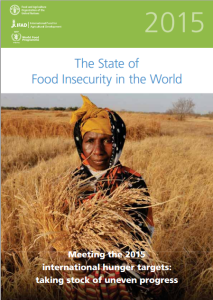SOFI 2015 | Progress achieved but much work remains to be done to overcome hunger and malnutrition
On 27 May 2015, the State of Food Insecurity (SOFI) in the World 2015 was released by the Food and Agriculture Organisation in Rome, Italy. According to the latest edition, the number of hungry people in the world has dropped to 795 million – 216 million…
 On 27 May 2015, the State of Food Insecurity (SOFI) in the World 2015 was released by the Food and Agriculture Organisation in Rome, Italy. According to the latest edition, the number of hungry people in the world has dropped to 795 million – 216 million fewer than in 1990-92 – or around one person out of every nine. The SOFI report, also known as the UN Hunger Report, is jointly prepared by the Food and Agriculture Organization of the United Nations (FAO), the International Fund for Agricultural Development (IFAD) and the World Food Programme (WFP).
On 27 May 2015, the State of Food Insecurity (SOFI) in the World 2015 was released by the Food and Agriculture Organisation in Rome, Italy. According to the latest edition, the number of hungry people in the world has dropped to 795 million – 216 million fewer than in 1990-92 – or around one person out of every nine. The SOFI report, also known as the UN Hunger Report, is jointly prepared by the Food and Agriculture Organization of the United Nations (FAO), the International Fund for Agricultural Development (IFAD) and the World Food Programme (WFP).
72 developing countries have reached the 2015 MDG 1 target of halving the proportion of hungry people
The 2015 report takes stock of progress made towards achieving the internationally established Millennium Development Goal (MDG1) and World Food Summit hunger targets and reflects on what needs to be done, as countries transition to the new post-2015 Sustainable Development Agenda. The report reviews progress made since 1990 for every country and region as well as for the world as a whole.
Progress towards the MDG 1 target, however, is assessed not only by measuring undernourishment, or hunger, but also by a second indicator – the prevalence of underweight children under five yearsof age. Progress for the two indicators across regions and over time, is compared, providing insights into the complexity of food security.
Global hunger has continued to decline, albeit gradually, to an estimated 795 million undernourished people, or a reduction of 167 million hungry people over the last ten years. This decline has been most pronounced in developing countries, despite significant population growth.
The report identifies much work remains to be done to eradicate hunger and achieve food security across all its dimensions. The 2015 report not only estimates the progress already achieved, but also identifies remaining problems, and provides guidance on which policies should be emphasized in the future. Key factors that have determined success to date towards food security and nutrition goals are also identified. The list of factors includes economic growth, agricultural productivity growth, markets (including international trade) and social protection. The report also shows how protracted crises, due to conflict or natural disasters, have deleterious effects on progress in hunger reduction.
“Hunger remains an everyday challenge for almost 795 million people worldwide, including 780 million in developing regions. Thus hunger eradication should remain a key commitment of decision-makers at all levels.” – José Graziano da Silva, FAO Director-General
Visit the FAO interactive SOFI website English | Français | Español | Русский | العربية
Download the publication English | Français | Español | Русский | العربية
Read SOFI In Brief English | Français | Español | Русский | العربية
See the press release English | Français | Español | Русский | العربية
Frequently Asked Questions English | Français | Español | Русский | العربية